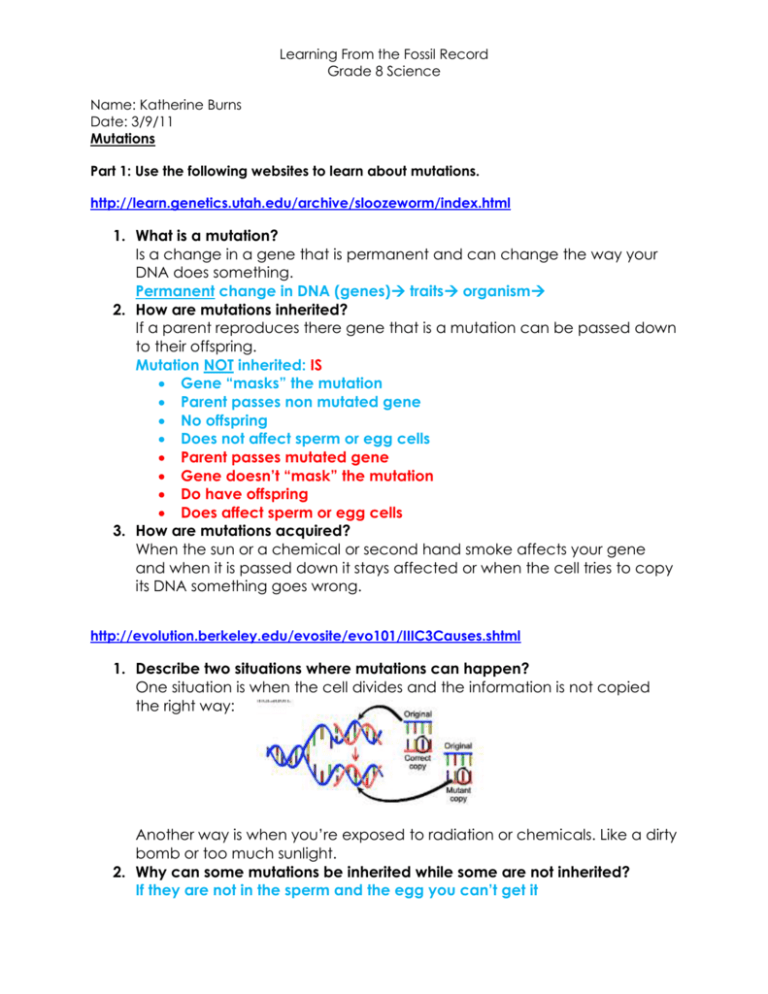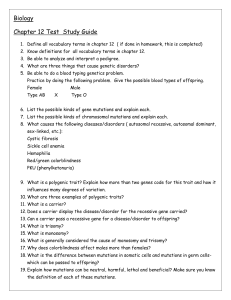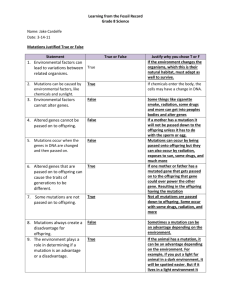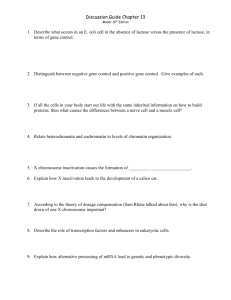Learning From the Fossil Record Grade 8 Science Name: Katherine
advertisement

Learning From the Fossil Record Grade 8 Science Name: Katherine Burns Date: 3/9/11 Mutations Part 1: Use the following websites to learn about mutations. http://learn.genetics.utah.edu/archive/sloozeworm/index.html 1. What is a mutation? Is a change in a gene that is permanent and can change the way your DNA does something. Permanent change in DNA (genes) traits organism 2. How are mutations inherited? If a parent reproduces there gene that is a mutation can be passed down to their offspring. Mutation NOT inherited: IS Gene “masks” the mutation Parent passes non mutated gene No offspring Does not affect sperm or egg cells Parent passes mutated gene Gene doesn’t “mask” the mutation Do have offspring Does affect sperm or egg cells 3. How are mutations acquired? When the sun or a chemical or second hand smoke affects your gene and when it is passed down it stays affected or when the cell tries to copy its DNA something goes wrong. http://evolution.berkeley.edu/evosite/evo101/IIIC3Causes.shtml 1. Describe two situations where mutations can happen? One situation is when the cell divides and the information is not copied the right way: Another way is when you’re exposed to radiation or chemicals. Like a dirty bomb or too much sunlight. 2. Why can some mutations be inherited while some are not inherited? If they are not in the sperm and the egg you can’t get it Learning From the Fossil Record Grade 8 Science Name: Katherine Burns Date: 3/9/11 Part 2: Using Punnett Squares to predict and follow mutations. 1. A heterozygous dominant black moth is crossed with a homozygous recessive white moth. Cross these and predict the offspring. 50% black moths and 50% white moths 2. The DNA in the recessive gene for white color is mutated by chemicals B found in the smog from a factory where the moth lives. This mutation b Bb causes the gene to show recessive brown instead of recessive white in only one moth. So now, even though the one moth is white it carries a recessive gene for brown. Cross the mutated homozygous white moth Bb b with a heterozygous black moth and predict the offspring. a. Do all the offspring get this mutation? Why or why not? No, only the moths that are homozygous recessive will have the mutation. If they have a dominant gene it won’t show. But they will have the mutated gene. b. Will there still be white moths in the population? It depends on how many moths have the mutated gene. If the moths without the mutated gene reproduce they would have white so it wouldn’t be extinct. But if that isn’t the case there won’t be a population of white moths. c. Will there still be black moths in the population? Yes because the mutation isn’t in the black only the white. b b B b Bb bb Bb bb 3. Summarize how mutations can be passed on and cause changes in a population of organisms. Mutations can cause changes in a population, because if the mutation gets passed on then something will become extinct. And that means something changed and maybe there will never be the same thing ever again. Mutations can change things so easily and with the littlest amount of work. b bb bb
![Mutation_Activity[1] - grade8learningfromfossils](http://s3.studylib.net/store/data/007384952_1-c3b6c23f01387a87bcbabf2708766d5f-300x300.png)








